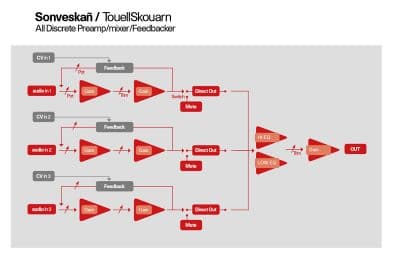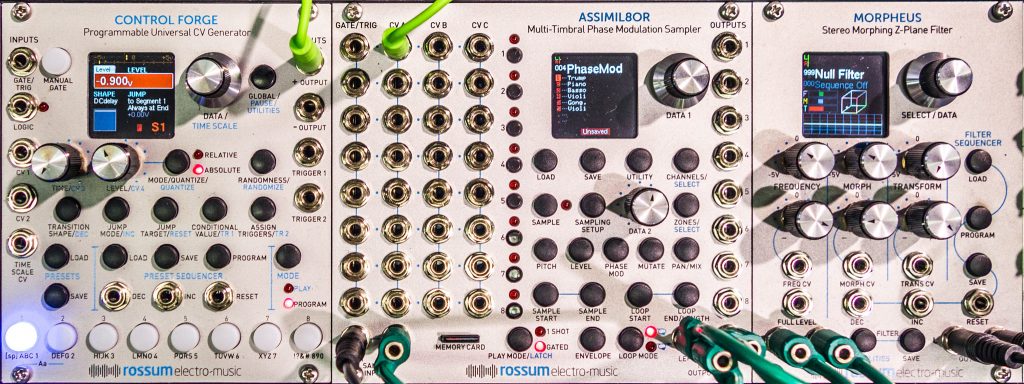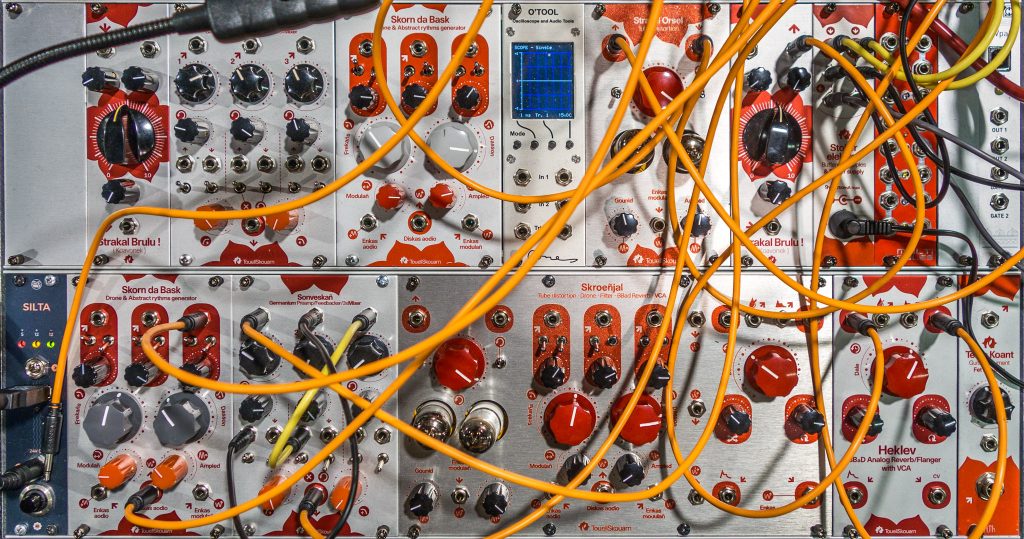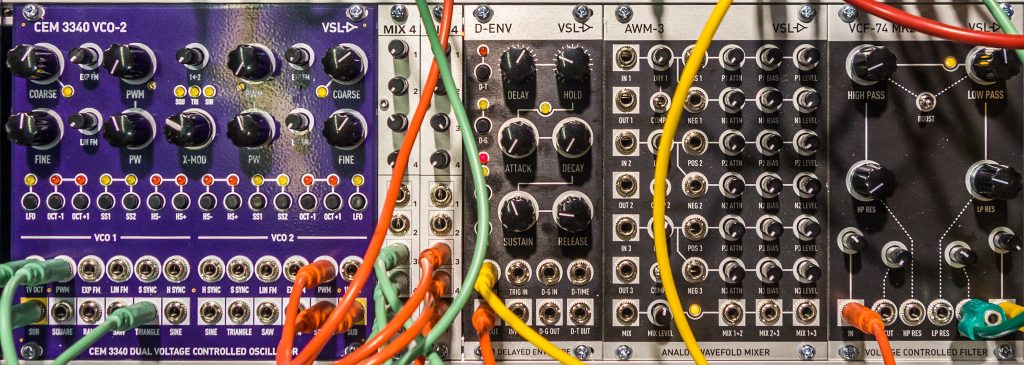Today’s installment is a study in extremes, going from exceptionally clean digital designs to purposely noisy and distorted analog ones, ending with a nice new envelope generator plus upcoming dual VCO.
Rossum Electro-Music
After a preview at last year’s NAMM show, the Rossum Assimil8or is almost ready to ship ($899, this March). “Rossum” is, of course, Dave Rossum, founder of E-mu Systems, which produced high-quality modular synths in their early days, later replaced by the much-loved line of Emulator samplers. The Assmil8tor brings those two worlds together, while heading off in a new direction.
At its most basic, the Assimil8or is an eight-channel sampler that can record mono or stereo (as well as load sound files from a front-panel SD card), and play back any combination of those up to its 8-channel limit. The user can choose the sample rate and bit depth (up to 32 bits and 192 kHz; the A/D and D/A sections are 24-bit), plus vary bit depth and aliasing as real-time voltage-controlled parameters. The frequency response goes down to DC, so you can also use the Assiml8or to record control voltages. Up to eight samples can be assigned to each channel, which again can be selected by real time CV. Samples can be triggered, looped, and gated with user-defined attack and release times; you can even “scrub” a sample under voltage control.
The special party trick of the Assimil8or is its ability to phase modulate a sample with either another sample or the sampling input. This means that while the main sample is trying to play forward in a linear fashion, the waveform of another sample can offset that playback counter forwards or backwards. Think of it as linear, through-zero FM for samples. The result reminds a few of us of “convolving” one sample with another using a program like Tom Erbe’s SoundHack where the harmonic content of one sound gets impressed upon another – but in real time. In addition to those sonic wonders, I suspect it will provide an interesting way to create complex modulation voltages (since the Assimil8or can also record DC). I have plans to get ahold of one of these; if I do, you’ll definitely see some videos from me later this year.
TouellSkouarn
One of the ways I feel the Eurorack world shows its relative youth is the way it pursues overdrive and distortion. There’s nothing at all wrong with distortion – ask almost any guitar player – but quite often I see Eurorack users just cranking everything up all the way and nodding in approval, thinking their job here is done…whereas guitarists as well as pedal and amp manufacturers spend a lot of time in pursuit of very particular tones and colors of distortion (watch the documentary Fuzz some time). Against that backdrop, I’m interested when I see another fuzz pedal company enter the world of modular.
TouellSkouarn is a French company I was previously unfamiliar with that creates hand-wired stomp boxes using tube and germanium transistor distortion circuits, as well as Eurorack modules. Some of his modules are focused on drones and LFO-driven rhythms, such as last year’s Skorn da Bask ($399), and this year’s expanded Skroeñjal which adds a tube distortion, bucket brigade device (BBD) delay, and VCA to the Bask’s core 3 VCOs/LFOs + filter. Just the tube distortion part of Skroeñjal will be available as the Strakal Orsel module (€335), which also has an internal filter with separate modulation input.

Vintage Synth Lab (VSL)
VSL brought two interesting new modules to NAMM: their D-Env envelope generator ($225; shipping now), and a very early prototype of a dual VCO based on the re-issued Curtis 3340 VCO chips.
Beyond being an exponential ADSR with a wide time range (0.8 msec to 180 seconds, depending on jumper settings), D-Env features both a Delay Pulse Processor and a Hold segment. It has several options for how the delay and hold are processed. For example, rather than just delay the start of the envelope, you can set up the D-Env so the envelope starts on the initial gate or trigger, and then is re-started after the Delay times out (12-1050 msec). It is certainly worth diving into the manual for this one; it’s like a patchable envelope generator.
The CEM 3340 VCO-2 is an interesting exercise in “Just what all can we do with these chips? What can we do with two?” Each side has both linear and exponential FM, two types each of hard and soft sync, PWM, and a suboctave in addition to the normal saw/square/tri/sine waves. Additionally, there is routing for one VCO to modulate the other, as well as to have cross modulation. VSL was taking input from users at the show, and I spent a lot of time chatting with them about dual and complex oscillator design. One thing that fell out of the conversation is that the 3340 chip is capable of through-zero linear FM (my personally preferred variation, as it stays in tune even at high modulation depths); it “just” requires additional external parts. Most other manufacturers using this chip have decided not to add these parts; I left NAMM with the impression that VSL will – which will certainly set this module apart from all of the other 3340-based VCOs that popped up at NAMM.




